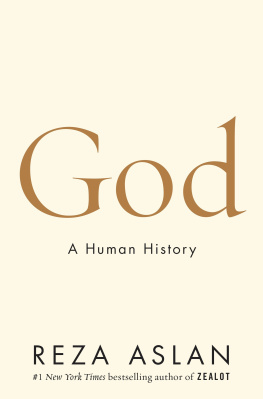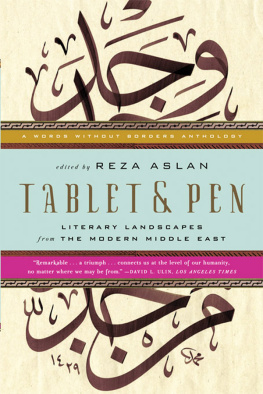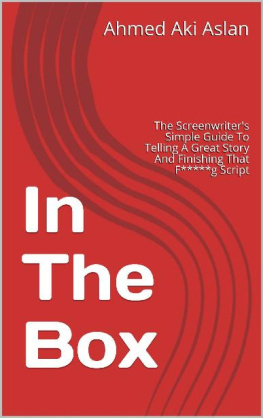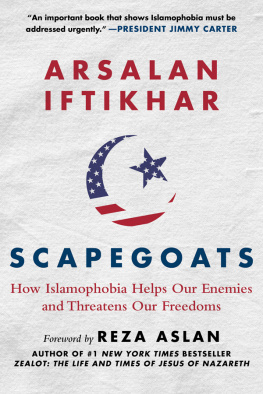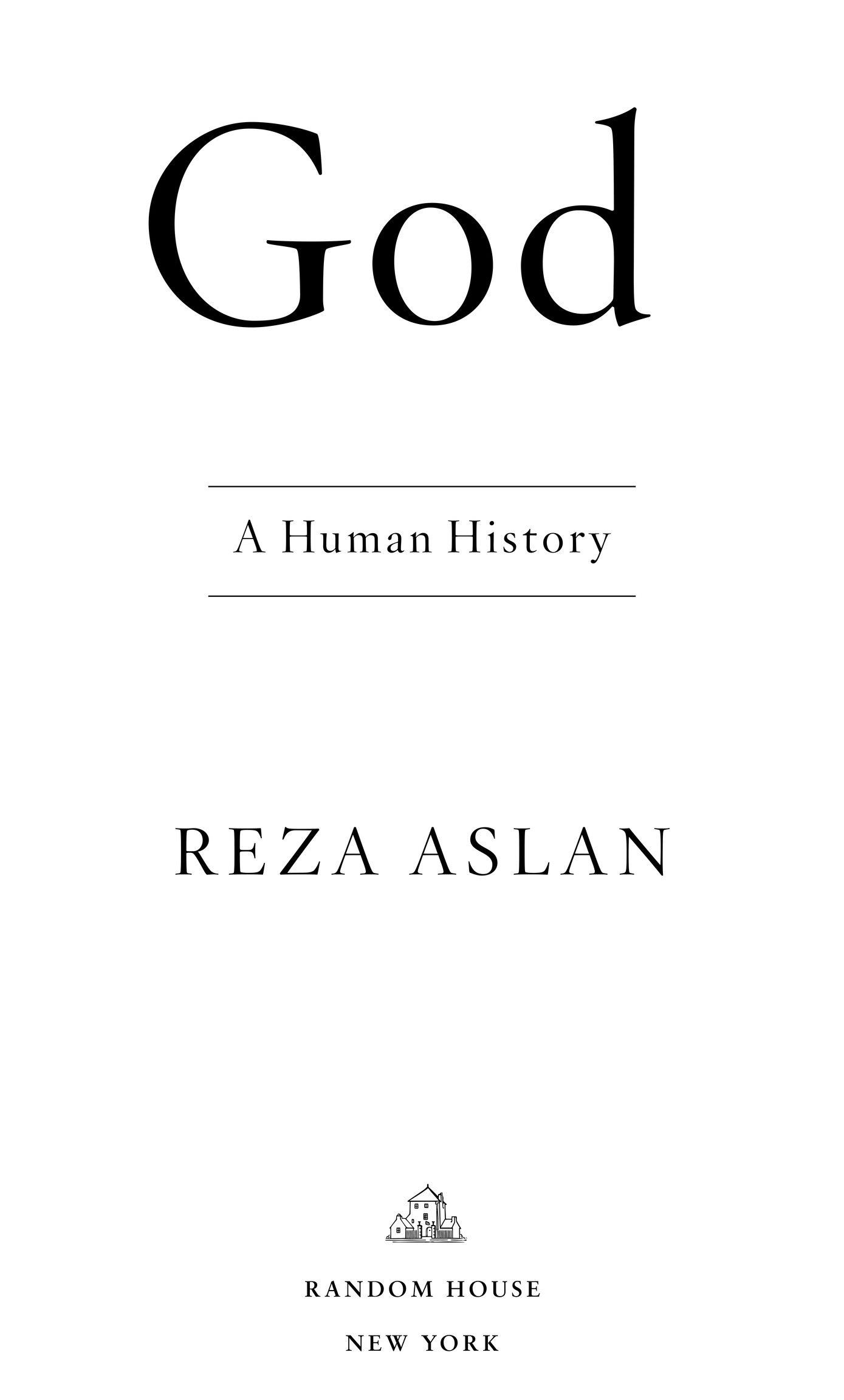Copyright 2017 by Aslan Media, Inc.
All rights reserved.
Published in the United States by Random House, an imprint and division of Penguin Random House LLC, New York.
R ANDOM H OUSE and the H OUSE colophon are registered trademarks of Penguin Random House LLC.
Names: Aslan, Reza, author.
Title: God : a human history / Reza Aslan.
Description: First Edition. | New York : Random House, 2017. |
Includes bibliographical references and index.
Subjects: LCSH: God.
Introduction
In Our Image
W HEN I WAS A CHILD, I thought God was a large, powerful old man who lived in the skya bigger, stronger version of my father, but with magical powers. I imagined him handsome and grizzled, his long gray hair draped over his broad shoulders. He sat on a throne enwrapped by clouds. When he spoke, his voice boomed through the heavens, especially when he was angry. And he was often angry. But he was also warm and loving, merciful and kind. He laughed when he was happy and cried when he was sad.
Im not sure where this image of God came from. I may have glimpsed it somewhere, painted on stained glass or printed in a book. It could be that I was born with it. Studies have shown that young children, no matter where they are from or how religious they may be, have a difficult time distinguishing between humans and God in terms of action or agency. When asked to imagine God, they invariably describe a human being with superhuman abilities.
As I grew older, I left behind most of my childish views. Yet the image of God remained. I was not raised in a particularly religious household, but I was always fascinated by religion and spirituality. My head teemed with half-formed theories about what God was, where he came from, and what he looked like (curiously, he still resembled my father). I didnt want to simply know about God; I wanted to experience God, to feel his presence in my life. Yet when I tried, I couldnt help but imagine a great chasm opening up between us, with God on one side, me on the other, and no way for either of us to cross over.
In my teens, I converted from the tepid Islam of my Iranian parents to the zealous Christianity of my American friends. All at once, that childhood urge to think of God as a powerful human being crystallized into the worship of Jesus Christ as literally God made flesh. At first, the experience felt like scratching an itch I had had my entire life. For years, Id been searching for a way to bridge the chasm between me and God. Now, here was a religion that claimed there was no chasm. If I wanted to know what God was like, all I had to do was imagine the most perfect human being.
It made a certain amount of sense. What better way to remove the barrier between human beings and God than by making God a human being? As the famed German philosopher Ludwig Feuerbach said, in accounting for the enormous success of Christianitys conception of God, only a being who comprises in himself the whole man can satisfy the whole man.
I first read that Feuerbach quote in college, just around the time I decided to embark on a lifelong quest to study the religions of the world. What Feuerbach seemed to be saying is that the near-universal appeal of a God who looks, and thinks, and feels, and acts just like us is rooted in our deep-seated need to experience the divine as a reflection of ourselves. That truth hit me like a clap of thunder. Is that why I was drawn to Christianity as a kid? Had I been constructing my image of God all this time as a mirror reflecting back to me my own traits and emotions?
The possibility left me feeling bitter and disillusioned. Seeking a more expansive conception of God, I abandoned Christianity and returned to Islam, drawn by the religions radical iconoclasm: the belief that God cannot be confined by any image, human or otherwise. I quickly recognized, however, that Islams refusal to depict God in human form did not translate into a refusal to think of God in human terms. Muslims are just as likely as other people of faith to ascribe to God their own virtues and vices, their own feelings and flaws. They have little choice in the matter. Few of us do.
It turns out that this compulsion to humanize the divine is hardwired in our brains, which is why it has become a central feature in almost every religious tradition the world has known. The very process through which the concept of God arose in human evolution compels us, consciously or not, to fashion God in our own image. In fact, the entire history of human spirituality can be viewed as one long, interconnected, ever-evolving, and remarkably cohesive effort to make sense of the divine by giving it our emotions and our personalities, by ascribing to it our traits and our desires, by providing it with our strengths and our weaknesses, even our own bodiesin short, by making God us. What I mean to say is that, more often than not, whether we are aware of it or not, and regardless of whether were believers or not, what the vast majority of us think about when we think about God is a divine version of ourselves: a human being but with superhuman powers.
This is not to claim that there is no such thing as God, or that what we call God is wholly a human invention. Both of these statements may very well be true, but that is not the concern of this book. I have no interest in trying to prove the existence or nonexistence of God for the simple reason that no proof exists either way. Faith is a choice; anyone who says otherwise is trying to convert you. You either choose to believe that there is something beyond the material realmsomething real, something knowableor you dont. If, like me, you do, then you must ask yourself another question: Do you wish to experience this thing? Do you wish to commune with it? To know it? If so, then it may help to have a language with which to express what is fundamentally an inexpressible experience.
That is where religion comes in. Beyond the myths and rituals, the temples and cathedrals, the dos and donts that have, for millennia, separated humanity into different and often competing camps of belief, religion is little more than a language made up of symbols and metaphors that allows believers to communicate, to one another and to themselves, the ineffable experience of faith. Its just that, throughout the history of religions, there has been one symbol that has stood out as universal and supremeone grand metaphor for God from which practically every other symbol and metaphor in nearly all the worlds religions has been derived: us; the human being.
This concept, which I call the humanized God, was embedded in our consciousness the moment the idea of God first occurred to us. It led to our earliest theorizing about the nature of the universe and our role in it. It informed our first physical representations of the world beyond ours. Belief in humanized gods guided us as hunter-gatherers, and then, tens of thousands of years later, led us to swap our spears for plows and begin planting instead. Our first temples were built by people who thought of the gods as superhuman beingsas were our first religions. The Mesopotamians, the Egyptians, the Greeks, the Romans, the Indians, the Persians, the Hebrews, the Arabs, all devised their theistic systems in human terms and with human imagery. The same holds true for nontheistic traditions, such as Jainism or Buddhism, both of which conceive of the spirits and devas that populate their theologies as superhuman beings who are, like their human counterparts, bound by the laws of karma.

